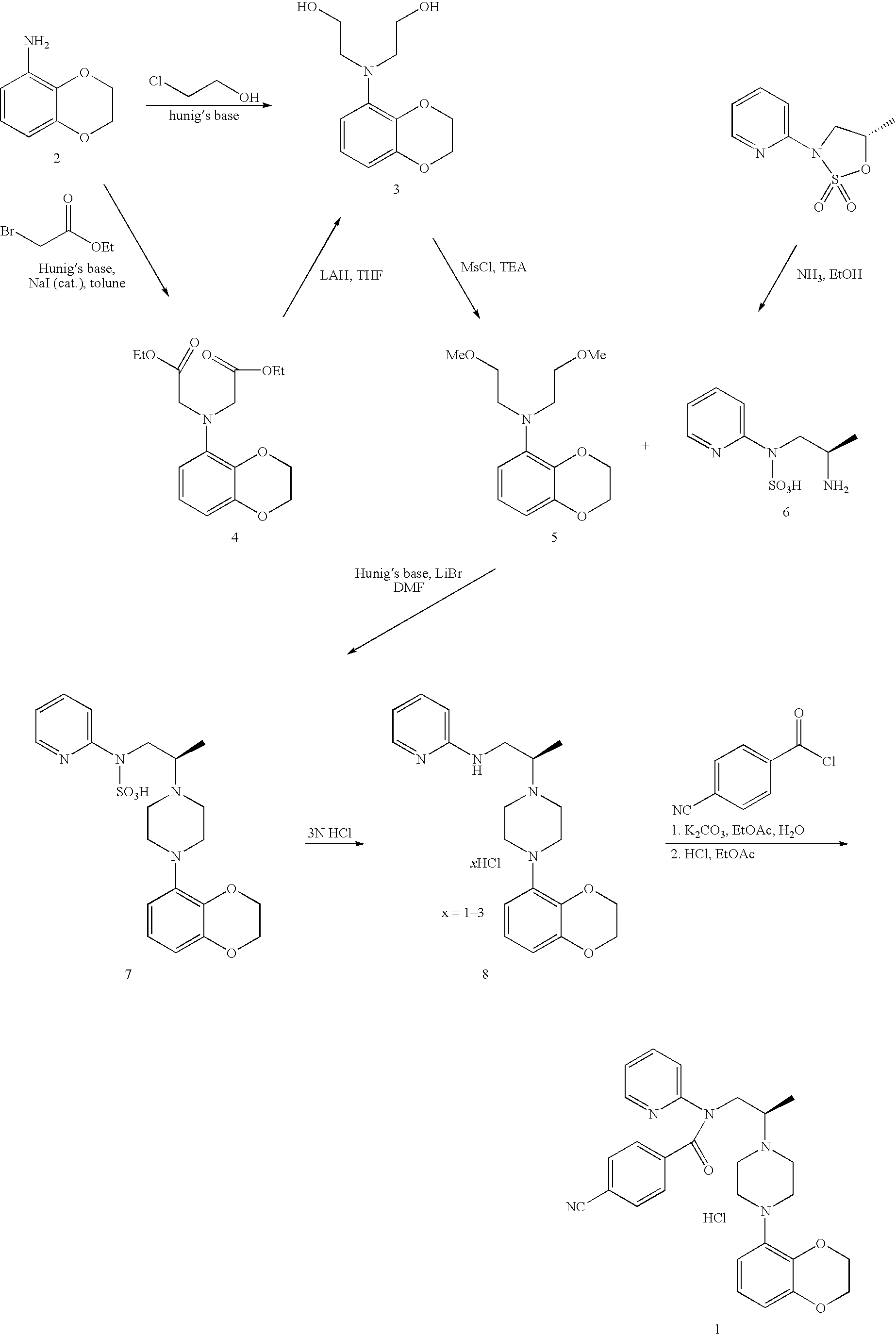Process for preparing N-aryl-piperazine derivatives
a technology of narylpiperazine and derivatives, which is applied in the field of preparing narylpiperazine derivatives, can solve the problems of difficult isolation of final products, affecting the yield and purity of final products, and less suitable for commercial scale processes for n-(2-pyridinyl)benzamid
- Summary
- Abstract
- Description
- Claims
- Application Information
AI Technical Summary
Benefits of technology
Problems solved by technology
Method used
Image
Examples
example 1
Preparation of the Hydrogen Chloride Salt of 2-[(2,3-dihydro-benzo[1,4]dioxon-5-yl)-(2-hydroxy-ethyl)-amino]-ethanol
[0140] A solution of benzodioxane aniline (50 g, 0.331 mol) in butyronitrile (150 mL) at room temperature was added sodium carbonate (70.2 g, 0.662 mole), sodium iodide (5 g, 0.033 mole), and chloroethanol (160 g, 133 mL). The reaction mixture was heated to reflux (115±5° C.). After 16 hours, it was cooled to room temperature then the suspension was filtered through a Büchner funnel. The solids were washed with ethyl acetate (2×100 mL). The combined filtrates were concentrated to ¼ of its original volume. Toluene (150 mL) was added followed by the addition of 10 N HCl in EtOH (66 mL). The reaction mixture was stirred at 23-25° C. overnight for 16 hours and then cooled to 0-5° C. for 2 hours. The product was filtered through a Büchner funnel, washed with toluene (2×50 mL), dried in a vacuum oven to give 79 g (86%) of diol HCl as a light purple solid.
[0141]1H NMR (CDCl...
example 2
Preparation of (2R)-2-aminopropyl(pyridin-2-yl)sulfamic acid
[0143] A mixture of sulfamate (25 g, 0.12 mol) in a 7.8 N ammonia in MeOH solution (270 mL, 2.1 mol) was stirred at room temperature under N2 for one day. The resulting mixture was concentrated to ⅓ its original volume then acetonitrile (80 mL) was added. The mixture was concentrated to ⅓ its original volume. Another portion of acetonitrile (80 mL) was added and the mixture was again concentrated to ⅓ its original volume. The suspension was heated at 40-45° C. for 10-15 minutes and then cooled to room temperature. The off-white solids was then filtered, washed with acetonitrile (50 mL), and dried in a vacuum oven to give 22 g (81%) of the sulfamic acid as an off-white solid (98 area % by LC / MS).
[0144]1H NMR (DMSO) δ 8.17 (d, J=3 Hz, 1H), 7.5-7.9 (m, 5H), 6.82 (t, J=4.5 Hz, 1H), 4.03 (dd, J=10.8 Hz, 3.6 Hz, 1H), 3.94 (dd, J=10.8 Hz, 5.7 Hz, 1H), 3.4-3.6 (m, 1H) 1.18 (d, J=5.1 Hz, 3H);
[0145]13C NMR (DMSO) δ 156.1, 146.8, 1...
example 3
Preparation of the Hydrogen Chloride Salt of {2-[4-(2,3-dihydrobenzo-[1,4]dioxin-5-yl)-piperazin-1-yl]-propyl}-pyridin-2-yl-amine)
[0146] A mixture of diol•HCl (50.0 g. 0.18 mol) in butyronitrile (250 mL) was cooled to 8-9° C. in an ice-water bath. To this mixture, methanesulfonyl chloride (74 g, 0.64 mol) was added followed by addition of triethylamine (TEA) (150 mL, 1.07 mol) over 30 minutes while keeping reaction temperature less than about 25° C. After addition, the reaction mixture was allowed to stir in the ice-water bath for an additional 30 minutes. At the end of this time, cold water (300 mL) was added. The two layers were separated. The aqueous layer was extracted with butyronitrile (100 mL). The combined butyronitrile layers was extracted with saturated NaHCO3 (300 mL) and H2O (300 mL). This dimesylate in butyronitrile solution was then added over 30 minutes to a mixture of aminosulfonic acid (37.4 g, 0.16 mol) and Hünig's base (127 mL, 0.727 mol) in butyronitrile (150 mL...
PUM
| Property | Measurement | Unit |
|---|---|---|
| temperature | aaaaa | aaaaa |
| temperature | aaaaa | aaaaa |
| temperature | aaaaa | aaaaa |
Abstract
Description
Claims
Application Information
 Login to View More
Login to View More - R&D
- Intellectual Property
- Life Sciences
- Materials
- Tech Scout
- Unparalleled Data Quality
- Higher Quality Content
- 60% Fewer Hallucinations
Browse by: Latest US Patents, China's latest patents, Technical Efficacy Thesaurus, Application Domain, Technology Topic, Popular Technical Reports.
© 2025 PatSnap. All rights reserved.Legal|Privacy policy|Modern Slavery Act Transparency Statement|Sitemap|About US| Contact US: help@patsnap.com



